The Tufted Titmouse is a gray and white, sparrow-sized bird with a perky little crest and pale orange flanks.
This species is a common and friendly bird of parks, woodlands, and backyard feeders. Watch for this sweet little bird at the feeder and in flocks with other small birds. Listen for them too; you’ll probably hear their call before you see them!
On this page
Identification
The Tufted Titmouse is a small, crested bird around the same size as a sparrow. This cute bird is easily recognized by its gray upperparts, pale underparts, and pale orange flanks.
Both sexes look alike and have a beady dark eye on a white face, and small black area just above their stubby black beak. Males are slightly bigger than females, but the difference is too small to notice in the field.
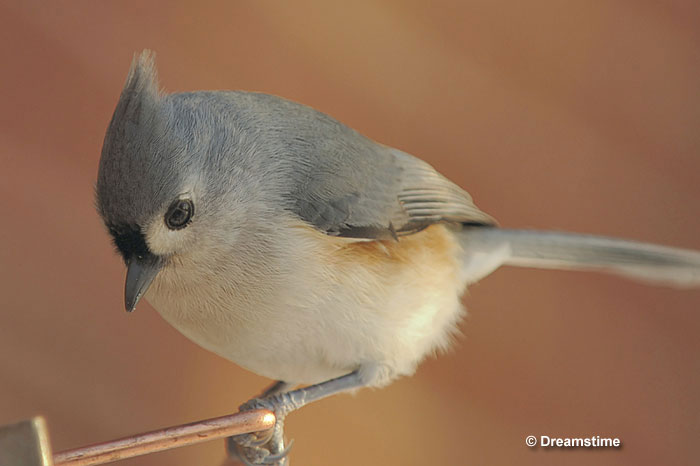
They also have medium-length, rounded wings and a medium-length tail. Juveniles look like adults but may be a bit paler and only have a tiny bit of black above their beak.
On average, the Tufted Titmouse is 6.5 inches long, has a wingspan of 9.75 inches, and weighs 0.75 ounces.
Since this bird lives in wooded areas, it doesn’t usually fly for long distances or in open areas. Instead, it has brief bursts of flight between trees and other vegetation.
During flight, its orange flanks are more obvious and its white underwings are visible.
The Tufted Titmouse is also very vocal and is often heard before the bird is seen. They make a constant, quick, whistled, “Peter Peter Peter” call over and over.
Food
The Tufted Titmouse has a pretty varied diet of insects, seeds, and fruit. They eat most insects they find but are especially fond of caterpillars. They also feed on beetles, bees, weevils, wasps, ants, treehoppers, and the egg cases of spiders and insects.
This species also eats various seeds, especially sunflower seeds and acorns. To crack seeds open, it often holds the seed down with one of its feet and hammers at it with its beak. Sometimes, they pick crushed acorns off the pavement of roads.
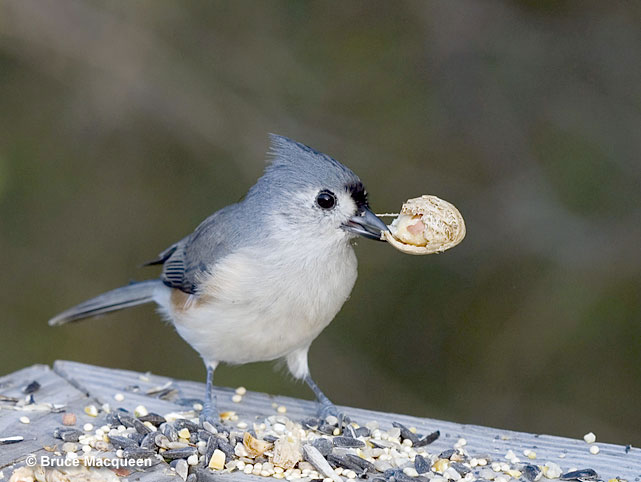
They can also pick nuts and acorns right from trees, and visit feeders for seeds. These adaptive little birds will also eat suet.
This species finds most of its food by foraging with flocks of chickadees and other small birds. As they move through woodlands, parks, and gardens, Tufted Titmice pick insects from bark and foliage. They often hop along branches and can acrobatically hang from twigs.
These industrious birds also explore crevices in bark, investigate squirrel nests and other leaf clusters for hidden insects, and do some of their foraging on the ground.
In fall and winter, like some other members of its family, the Tufted Titmouse hides seeds and nuts under bark and in crevices.
Nesting and Eggs
The Tufted Titmouse nests inside tree cavities and often uses holes made by woodpeckers. The nest is usually 30 feet or so above the ground and can be in a hole in any number of tree species.
After a nesting cavity is chosen, the female uses bits of bark, moss, and other plant matter to make a shallow cup nest at the bottom of the hole.
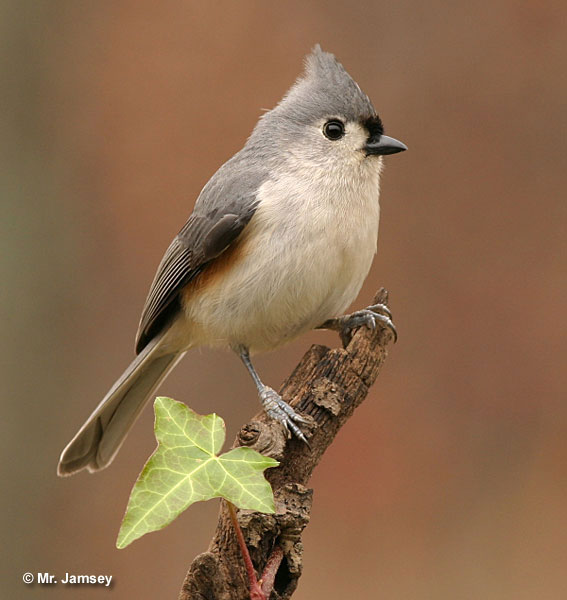
She lines the inside of the nest with hair, cotton, or other soft materials. To obtain hair for their nests, these birds sometimes pick it from horses and even people!
This species lays anywhere from three to nine cream-colored eggs with small reddish markings (usually five to six eggs). The eggs are .7 to .8 inches long and the female incubates them for around two weeks.
During the incubation period, male Tufted Titmice bring food to the female. After the eggs hatch, both parents bring food to the young. The nestlings leave the nest after around 15 or 16 days.
After leaving the nest, the young Titmice hide within foliage as their parents visit to feed them. They begin to do some feeding on their own five days after hatching, and at 6 weeks of age, the young birds do all of their own foraging.
Current Situation
The Tufted Titmouse frequents oak woodlands, parks, and towns with lots of big trees in most of the eastern USA. They live north to Wisconsin, southeastern Minnesota, and southern Maine. This bird also occurs in southern Ontario and part of southern Quebec.
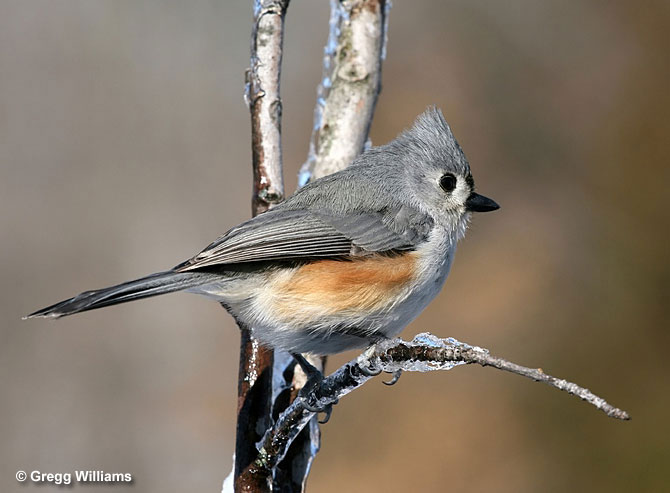
The Tufted Titmouse is listed as Least Concern in the IUCN Red List.
In most of its range, this bird species is common and easy to see. Although there aren’t as many at the northern and western borders of their distribution, overall, the Tufted Titmouse is doing very well.
These adaptable birds are especially frequent in parks with lots of big trees, and are regular visitors to big gardens, especially ones with bird feeders. Even so, the Tufted Titmouse can be affected by the removal of dead trees that provide old woodpecker holes needed by this species for its nests.
Facts
- Pairs of Tufted Titmice usually stay within their territories all year long. They even do this in the winter months when many other small birds flock together and wander over a general area.
- This species stores many of the seeds that it takes from feeders. It shells the seed before hiding it under some bark, usually 100 feet or so from the feeder itself.
- Although the Tufted Titmouse nests in tree cavities, it can’t excavate its own nesting hole. They need holes made by woodpeckers, usually in dead trees, and the more tree cavity options the better.
- To give their babies a nice soft bed, this species often lines its nest with hair from mammals. They have been recorded using hair from several animals including Raccoons, Squirrels, pets, people, and Opossums.
- As a result of a warming climate, this non-migratory bird has been gradually expanding north for several decades.
Similar Species
With its crest and color pattern, few other birds look like the Tufted Titmouse. However, there are a few other related species that are similar.
Black-crested Titmouse
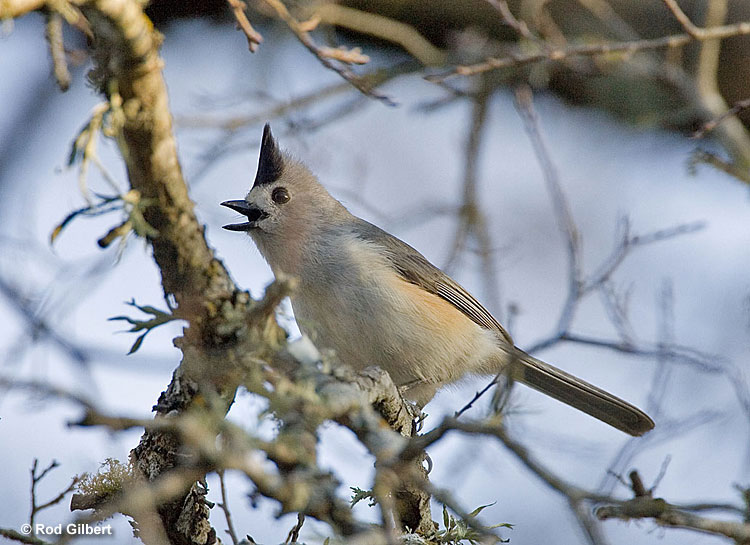
The Black-crested Titmouse is closely related and looks just like the Tufted Titmouse except that it has black on its crest.
It also replaces the Tufted Titmouse in northeastern Mexico, and central, western, and eastern Texas.
Juniper Titmouse

Juniper Titmouse has a similar shape but has much more uniform coloration, a shorter crest, and doesn’t live anywhere near the Tufted Titmouse.
Oak Titmouse

Photograph © Greg Lavaty
Although the Oak Titmouse looks similar to Tufted Titmouse, this little bird is restricted to California, far away from the Tufted Titmouse.
Frequently Asked Questions
What is special about a Tufted Titmouse?
The Tufted Titmouse is special because it’s a cute, crested bird that takes seeds from bird feeders and hides them for later use.
Why do they call it a titmouse?
They call it a titmouse because it belongs to the same family as the “titmice” of Eurasia. These birds get their name from an old word for small birds and their gray, mouse-like coloration.
Where does a Tufted Titmouse live?
The Tufted Titmouse lives in oak woodlands, parks, and large gardens in much of the eastern USA and some parts of southeastern Canada.
How smart is a titmouse?
The titmouse is believed to be one of the more intelligent of small birds. They seem to be curious about people and where people live, have to recall where they hide food, and have to figure out how to break open nuts so they can eat them.
How do Tufted Titmouse survive the winter?
The Tufted Titmouse survives the winter by storing seeds and nuts under bark and other hiding places. When food becomes scarce, it can live off that stored food.


